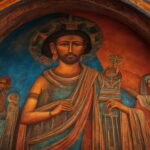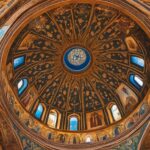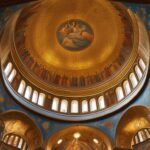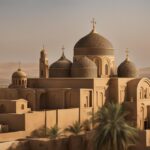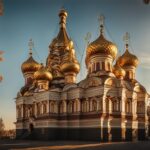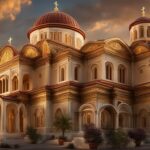The Ethiopian Orthodox Church, rooted in the ancient Ethiopian Christian tradition, has a remarkable history that dates back to 328 AD. Founded by Frumentius, a Syrian bishop consecrated by Saint Athanasius, it is one of the oldest Christian traditions in the world. The Ethiopian Orthodox Church holds a profound significance in Ethiopian religion and has become an integral part of the country’s cultural and spiritual identity.
This vibrant and resilient church has persevered through periods of persecution, demonstrating unwavering faith and devotion. Its long and storied history is a testament to the enduring strength of Ethiopian Christianity and the profound impact it has had on the lives of millions of people.
Origins of the Ethiopian Orthodox Church
The origins of the Ethiopian Orthodox Church can be traced back to the first century AD, when the Ethiopian eunuch, baptized by the Apostle Philip, brought the Christian faith to Ethiopia. The church’s first bishop, Frumentius, was consecrated by Saint Athanasius, further solidifying the connection between Ethiopia and the early Christian apostles.
From its humble origins, the Ethiopian Orthodox Church has grown and thrived, influencing the spiritual landscape of the country and shaping the lives of its faithful followers.
Key Takeaways:
- The Ethiopian Orthodox Church is one of the oldest Christian traditions in the world.
- It was founded in 328 AD by Frumentius, consecrated by Saint Athanasius.
- The church traces its origins back to the first century AD, when the Ethiopian eunuch embraced Christianity.
- Embracing the teachings of the Apostle Philip and the early apostles, the church has remained steadfast in its beliefs.
- The Ethiopian Orthodox Church has played a vital role in shaping Ethiopian religion and culture.
Origins of the Ethiopian Orthodox Church
The Ethiopian Orthodox Church has its origins rooted in the early days of Christianity, tracing back to the first century AD. It is believed that the Ethiopian eunuch, who had been baptized by the Apostle Philip, played a significant role in bringing the Christian faith to Ethiopia.
Legend has it that the Ethiopian eunuch was traveling back to his home country when he encountered Apostle Philip. Impressed by Philip’s teachings, the eunuch eagerly embraced the Christian faith and sought baptism. This pivotal moment marked the beginning of the Ethiopian Orthodox Church’s journey.
The story continues with the consecration of Frumentius as the first bishop of the church by Saint Athanasius. Frumentius, who had been taken captive in Ethiopia as a child, went on to become a prominent figure in spreading Christianity throughout the region. His appointment as bishop solidified the foundation of the Ethiopian Orthodox Church.
Throughout its history, the Ethiopian Orthodox Church has encountered numerous challenges and faced periods of persecution. Yet, it has remained unwavering in its beliefs, holding steadfast to its roots and maintaining its distinctive traditions.
“The Ethiopian Orthodox Church’s origins are deeply intertwined with the story of the Ethiopian eunuch and the Apostle Philip. It is a testament to the church’s enduring faith and resilience.” – [Your Name]

| Key Figures | Significance |
|---|---|
| Ethiopian Eunuch | Brought the Christian faith to Ethiopia |
| Apostle Philip | Baptized the Ethiopian eunuch |
| Frumentius | Consecrated as the first bishop by Saint Athanasius |
Beliefs and Doctrines of the Ethiopian Orthodox Church
The Ethiopian Orthodox Church is deeply rooted in its beliefs and upholds the teachings of the Nicene Creed, which has been an integral part of Christian doctrine for centuries. Central to its faith is the recognition of the Holy Trinity—the Father, the Son (Jesus Christ), and the Holy Spirit—each possessing divinity and playing a significant role in the salvation of humanity.
The church places great importance on the incarnation of Jesus Christ, acknowledging both his divinity and humanity. It believes that through his birth, life, death, and resurrection, Jesus Christ provided a path for salvation and reconciled humanity with God.
The Ethiopian Orthodox Church follows a rich set of theological teachings and doctrines that guide its practices and worship. These teachings encompass various aspects of the faith, including the nature of God, the role of the church in salvation, the sacraments, and moral principles for living a righteous life.
One of the key beliefs of the Ethiopian Orthodox Church is the conviction that the true body and blood of Jesus Christ are present in the Eucharist during the Divine Liturgy. This sacrament is seen as a tangible way to partake in the sacrifice of Christ and to maintain a spiritual communion with Him.
Seven Sacraments
In addition to the Eucharist, the Ethiopian Orthodox Church recognizes six other sacraments, which are considered important milestones in the spiritual journey of its members:
- Baptism: A sacred ceremony marking initiation into the Christian faith.
- Confirmation: A sacrament where individuals receive the Holy Spirit and are confirmed as members of the church.
- Confession: A practice of confessing sins and seeking forgiveness within the church community.
- Ordination: The process by which individuals are ordained as deacons, priests, or bishops within the church hierarchy.
- Matrimony: The sacrament of marriage, emphasizing the sacred union between a man and a woman.
- Unction of the Sick: A sacrament where the church offers prayers and anoints the sick, invoking divine healing and comfort.
These sacraments play a pivotal role in the spiritual life of Ethiopian Orthodox Christians, offering them opportunities for grace, spiritual growth, and deeper connection with God.
Rich Theological Heritage
The Ethiopian Orthodox Church has developed a profound theological heritage that encompasses historical teachings and interpretations of scripture. Its doctrines are influenced by early Christian theologians such as Saint Athanasius and Saint Cyril of Alexandria.
The church places a strong emphasis on the sacredness and authority of scripture, including the Old and New Testaments. It also recognizes additional texts, such as the Books of Enoch and the Books of Maccabees, which are considered part of the canon.
Through its teachings and doctrines, the Ethiopian Orthodox Church seeks to guide its followers in their spiritual journey, providing a framework for moral conduct, worship, and prayer.
Sacraments and Rituals of the Ethiopian Orthodox Church
The Ethiopian Orthodox Church embraces a profound spiritual journey through the practice of sacraments and rituals. These sacred ceremonies form the cornerstone of the Ethiopian Christian tradition, fostering a deep connection with God and the community.
Sacraments:
The Ethiopian Orthodox Church observes seven sacraments, each holding immense spiritual significance:
- Baptism: This sacrament marks the initiation into the Christian faith, cleansing the soul and symbolizing rebirth.
- Confirmation: Through confirmation, individuals receive the Holy Spirit and strengthen their commitment to their faith.
- Eucharist: Also known as the Holy Communion, this sacrament commemorates the Last Supper, where the body and blood of Christ are believed to be present in the bread and wine.
- Anointing of the Sick: A sacred ritual performed to provide comfort and healing to the ill, invoking divine intervention.
- Confession: Through the sacrament of confession, believers seek forgiveness for their sins and receive spiritual guidance from a priest.
- Ordination: This sacrament sanctifies individuals who are called to serve as deacons, priests, or bishops within the church hierarchy.
- Matrimony: The sacrament of marriage unites couples in the presence of God, signifying a lifelong commitment and spiritual partnership.
Rituals and Ceremonies:
Beyond the sacraments, the Ethiopian Orthodox Church also celebrates a variety of rituals and ceremonies that enrich the worship experience:
- Timket: A vibrant and colorful festival commemorating the baptism of Jesus in the River Jordan.
- Meskel: Celebrated around September, this festival commemorates the finding of the True Cross by Saint Helena.
- Enkutatash: Also known as the Ethiopian New Year, this festival marks the end of the rainy season and the beginning of a new agricultural year.
- Epiphany: Celebrated on January 19th, Epiphany is a significant holiday that commemorates the baptism of Jesus Christ.
These rituals and ceremonies serve to connect members of the Ethiopian Orthodox Church with their ancient traditions and holy events.
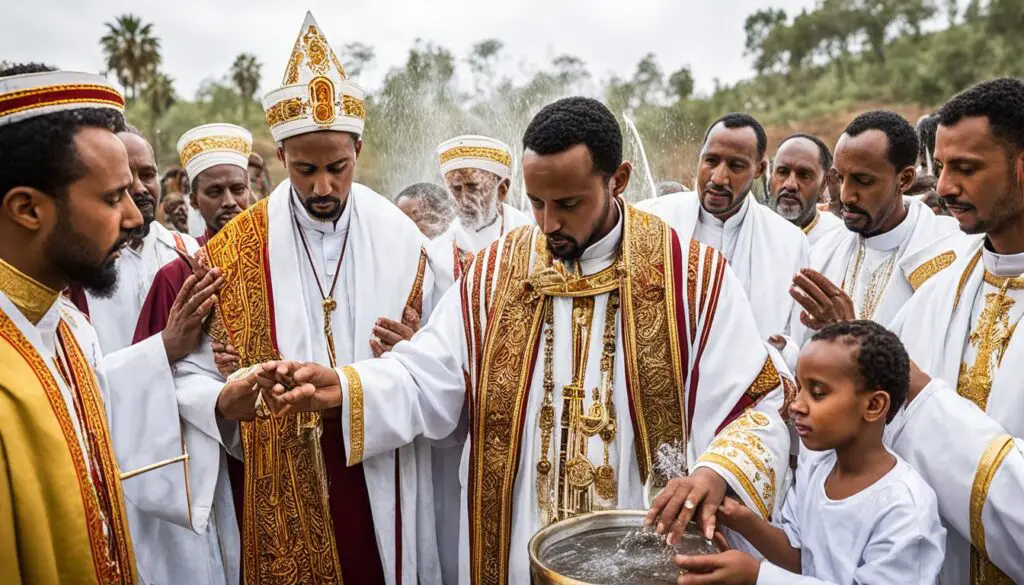
“The sacraments and rituals of the Ethiopian Orthodox Church form a sacred tapestry that binds believers to their faith, offering them profound moments of connection with God and their community.”
Through the practice of sacraments and rituals, the Ethiopian Orthodox Church cultivates a deep spirituality and provides a framework for believers to experience the divine presence in their lives. These sacred traditions nurture the soul, strengthen the bond among community members, and uphold the cherished values that have endured throughout centuries.
Leadership and Clergy of the Ethiopian Orthodox Church
The Ethiopian Orthodox Church is guided by a dedicated leadership and clergy, ensuring the spiritual welfare of its followers. At the helm of the church is the patriarch, who holds the highest authority in matters of church administration and justice. The patriarch serves as the spiritual head, offering guidance and direction to the Ethiopian Orthodox faithful.
Assisting the patriarch are the bishops and priests, who play crucial roles in the spiritual guidance and pastoral care of the church members. Bishops are responsible for overseeing specific regions or dioceses, ensuring the smooth functioning of the church within their jurisdictions. They provide spiritual guidance, perform sacraments, and supervise the clergy under their authority.
Priests, on the other hand, are ordained ministers who lead congregations, administer sacraments, and provide pastoral support to the Ethiopian Orthodox community. They undergo rigorous training and education to develop the necessary skills and knowledge to serve the church and its people. With their deep understanding of scripture and the teachings of the church, priests play a pivotal role in nurturing the spiritual growth and well-being of the faithful.
Within the Ethiopian Orthodox Church, the clergy serves as a bridge between God and the community, upholding the rich traditions and values of the Ethiopian Christian faith. Their commitment to their vocation is unwavering, as they dedicate their lives to serving the needs of the church and its followers.
“The Ethiopian Orthodox Church is blessed with an esteemed leadership and dedicated clergy who guide and nurture the spiritual journey of the faithful, ensuring the preservation and growth of our Ethiopian Christian tradition.”

Through their presence and guidance, the Ethiopian Orthodox leadership and clergy inspire and uplift the community, fostering a deep sense of faith, unity, and devotion. Their commitment to upholding the teachings and values of the church enables the Ethiopian Orthodox Church to thrive and continue its significant role in the spiritual lives of Ethiopians and beyond.
Worship Practices of the Ethiopian Orthodox Church
The Ethiopian Orthodox Church has a deep-rooted tradition of worship that encompasses prayers, hymns, and liturgical services. This ancient Christian denomination holds its worship practices in high regard, reflecting the devotion and spirituality of its followers.
Central to the worship in the Ethiopian Orthodox Church are prayers, which serve as a means of communication with God. These prayers are often recited throughout the day by individuals as well as in communal gatherings. They are considered essential for strengthening one’s faith and establishing a deeper connection with the divine.
“Prayer is not asking. It is a longing of the soul. It is a daily admission of one’s weakness. It is better in prayer to have a heart without words than words without a heart.” – Mahatma Gandhi
In addition to prayers, the Ethiopian Orthodox Church places great importance on hymns and chants. These melodic expressions of faith are sung during worship services, adding a sense of reverence and joy to the congregation. The hymns often praise God, recount biblical stories, and invoke spiritual blessings.
“Sing to the LORD a new song; sing to the LORD, all the earth. Sing to the LORD, praise his name; proclaim his salvation day after day.” – Psalm 96:1-2

Liturgical services are a significant part of the worship practices in the Ethiopian Orthodox Church. These services follow a structured and ceremonial format, incorporating various rituals, processions, and readings from sacred texts. The language used in these services is primarily Geez, an ancient liturgical language, although some parts may also be conducted in Amharic.
Fasting periods hold a special place in Ethiopian Christian practices, and they are observed with utmost dedication. The faithful willingly abstain from certain foods and activities as a form of spiritual discipline and self-restraint. Fasting is seen as a means of purification, reflection, and drawing closer to God.
The Ethiopian Orthodox Church also celebrates feasts and holy days throughout the liturgical year. These occasions mark significant events in the life of Christ, the Virgin Mary, and the saints. They provide opportunities for the faithful to come together in worship, receive blessings, and strengthen their devotion.
| Worship Practices | Description |
|---|---|
| Prayers | Recited throughout the day; essential for spiritual connection and faith strengthening. |
| Hymns and Chants | Sung during worship services; praise God, recount biblical stories, and invoke blessings. |
| Liturgical Services | Structured ceremonial format incorporating rituals, processions, and readings. |
| Fasting | Observed as a form of spiritual discipline, self-restraint, and purification. |
| Feasts and Holy Days | Celebrations marking significant events in the life of Christ, the Virgin Mary, and the saints. |
Through these worship practices, the Ethiopian Orthodox Church fosters a sense of unity, devotion, and reverence among its members. It is in this sacred space that believers find solace, inspiration, and a deepening of their spiritual journey.
Sacred Texts of the Ethiopian Orthodox Church
The Ethiopian Orthodox Church holds the Bible as its sacred text, encompassing both the Old and New Testaments. These scriptures form the foundation of Ethiopian Christian faith, providing guidance and inspiration to its followers.
Within the Ethiopian Orthodox Church, there is also recognition of additional books that are considered part of its canon. These include the Books of Enoch and the Books of Maccabees. The inclusion of these texts reflects the unique theological perspectives and traditions of the Ethiopian Orthodox Church.
The Bible and the supplementary texts play a pivotal role in shaping the beliefs and practices of the church. They are studied, meditated upon, and invoked during religious ceremonies and liturgical services.
“The scriptures are a wellspring of divine wisdom, offering solace, guidance, and enlightenment to all who seek the path of righteousness.” – Ethiopian Orthodox Church
With the Bible as the centerpiece, the Ethiopian Orthodox Church explores the significance of the Old Testament, including the stories of creation, the prophets, and the covenant between God and His chosen people. The New Testament reveals the life, teachings, death, and resurrection of Jesus Christ, emphasizing His role as the Savior and the cornerstone of Christian faith.
Through the study of these sacred texts, the Ethiopian Orthodox Church seeks to deepen the spiritual connection between its members and God. The scriptures are a source of inspiration, moral guidance, and spiritual nourishment.
Canonical Books of the Ethiopian Orthodox Church
| Old Testament | New Testament | Additional Canonical Books |
|---|---|---|
| Genesis | Matthew | Books of Enoch |
| Exodus | Mark | Books of Maccabees |
| Leviticus | Luke | |
| Numbers | John | |
| Deuteronomy | Acts | |
| Joshua | Romans | |
| Judges | 1 Corinthians | |
| Ruth | 2 Corinthians | |
| 1 Samuel | Galatians | |
| 2 Samuel | Ephesians | |
| 1 Kings | Philippians | |
| 2 Kings | Colossians | |
| 1 Chronicles | 1 Thessalonians | |
| 2 Chronicles | 2 Thessalonians | |
| Ezra | 1 Timothy | |
| Nehemiah | 2 Timothy | |
| Esther | Titus | |
| Job | Philemon | |
| Psalms | Hebrews | |
| Proverbs | James | |
| Ecclesiastes | 1 Peter | |
| Song of Solomon | 2 Peter | |
| Isaiah | 1 John | |
| Jeremiah | 2 John | |
| Lamentations | 3 John | |
| Ezekiel | Jude | |
| Daniel | Revelation |
The Ethiopian Orthodox Church regards these texts as holy and imbued with divine wisdom. They continue to shape the faith, spirituality, and cultural identity of the Ethiopian Christian community, offering a glimpse into the rich spiritual heritage of the church.
Denominations and Sects within the Ethiopian Orthodox Church
The Ethiopian Orthodox Church, as the largest denomination within the Oriental Orthodox family of churches, encompasses various dioceses and parishes not only within Ethiopia but also across different countries. Although the church operates under a unified structure, there may be slight variations in practices and customs from one region to another. These differences add a unique richness to the Ethiopian Orthodox denominations and Christian sects, further reflecting the diverse cultural heritage and spiritual expressions within the church.
“The strength of the Ethiopian Orthodox Church lies in its unity of faith, despite the differences in regional practices. This unity binds us together as a community, fostering a sense of belonging and shared purpose.”
With reverence for its ancient roots and a commitment to preserving the traditions handed down through generations, the Ethiopian Orthodox Church continues to shine as a beacon of spiritual devotion and cultural identity. Through its denominational diversity, the church provides believers with different paths to express their faith while upholding the core beliefs and principles that unite them.
| Denominations | Distinct Characteristics |
|---|---|
| 1. Ethiopian Tewahedo Orthodox Church | The largest and most widespread denomination within the Ethiopian Orthodox Church; its teachings and practices are observed by the majority of Ethiopian Orthodox Christians. |
| 2. Eritrean Orthodox Tewahedo Church | With historical ties to the Ethiopian Orthodox Church, this denomination serves the Eritrean Orthodox population, emphasizing the unique cultural and linguistic aspects of Eritrea. |
| 3. Ethiopian Orthodox Church in the Diaspora | Comprising Ethiopian Orthodox communities outside of Ethiopia, this denomination serves as a spiritual anchor and cultural support system for Ethiopians living abroad. |
| 4. Ethiopian Orthodox Church Abroad | Also known as the Ethiopian Orthodox Tewahedo Church Archdiocese of the Western Hemisphere, this denomination caters to Ethiopian Orthodox Christians residing primarily in North America. |
The denominations within the Ethiopian Orthodox Church are unified in their devotion to the Ethiopian Christian faith, exemplifying the resilience and spiritual strength that have shaped the church throughout its long history.

Through the denominations and sects within the Ethiopian Orthodox Church, believers find a spiritual home where they can worship, pray, and connect with fellow believers. This sense of community and shared spiritual journey fosters deep bonds and strengthens their connection to God and to each other.
Community and Outreach in the Ethiopian Orthodox Church
The Ethiopian Orthodox Church places a strong emphasis on community and outreach, demonstrating its commitment to serving its members and the broader society. Through various social and charitable initiatives, the church actively engages in activities that promote the well-being and support of its community. These endeavors aim to improve the lives of individuals and foster a sense of unity and compassion.
One of the key areas of focus for the Ethiopian Orthodox Church is education. The church runs schools and seminaries to train clergy and provide religious education to its members. By investing in education, the Ethiopian Orthodox Church aims to empower individuals with knowledge and skills that will enable them to contribute meaningfully to society.
Furthermore, the Ethiopian Orthodox Church conducts outreach programs to address the needs of marginalized communities and vulnerable individuals. This includes support for orphanages, healthcare services for the underprivileged, and assistance for those affected by natural disasters or other crises. Such efforts embody the church’s commitment to social justice and its desire to alleviate suffering.
“We believe that the love and compassion shown through our community and outreach efforts are a means of expressing our faith and fulfilling our spiritual calling. It is through service to others that we find true fulfillment and unity in the Ethiopian Orthodox community.” – His Holiness Abune Mathias, Patriarch of the Ethiopian Orthodox Church
Through its community and outreach initiatives, the Ethiopian Orthodox Church demonstrates its core values of love, compassion, and selflessness. By actively engaging in social and charitable activities, the church seeks to bring positive change to individuals’ lives and contribute to the overall well-being of the Ethiopian society.
Architectural and Artistic Features of the Ethiopian Orthodox Church
The Ethiopian Orthodox Church is renowned for its exquisite architectural and artistic elements, showcasing the fusion of faith, culture, and artistic expression. From magnificent churches to intricately adorned monasteries, the architectural features of Ethiopian Orthodox buildings are truly breathtaking.
“The Ethiopian Orthodox Church showcases a unique blend of architectural styles, combining influences from ancient Axumite traditions and the Byzantine Empire. These structures are not only places of worship but also focal points of cultural identity and spiritual significance for the Ethiopian Christian community.”
The churches and monasteries are characterized by their distinctive designs, often featuring circular or octagonal shapes, with towering domes and intricate carvings. The use of geometric patterns, symbolic motifs, and vibrant colors in the architecture reflects the rich cultural heritage and deep spirituality of the Ethiopian Orthodox Church.
Inside these sacred spaces, visitors are greeted by a visual feast of vibrant murals, religious paintings, and intricately carved wooden ceilings. These artistic expressions depict scenes from biblical stories, as well as saints and angels, enveloping worshippers in a spiritual ambiance.
The Ethiopian Orthodox Church has preserved its artistic traditions through centuries, with skilled artisans passing down their techniques and knowledge from one generation to another. The meticulous attention to detail and the use of traditional materials make each piece of art a masterpiece that evokes a sense of wonder and reverence.
These architectural and artistic features not only contribute to the aesthetic beauty of the Ethiopian Orthodox Church but also serve as a source of inspiration and a tangible representation of the devotion and spirituality of its followers.
Contemporary Issues and Challenges for the Ethiopian Orthodox Church
The Ethiopian Orthodox Church, like any religious institution, faces various contemporary issues and challenges in the modern world, both within Ethiopia and in the diaspora. Addressing these challenges requires a delicate balance between preserving traditions and adapting to societal changes.
Social Change and Preservation of Cultural Traditions
One of the key challenges for the Ethiopian Orthodox Church is navigating social change while preserving cultural traditions. As Ethiopian society undergoes transformations, influenced by factors such as globalization and modernization, the church must find ways to remain relevant and engage a changing demographic, especially among the younger generation.
The church must walk a fine line between embracing new ideas and technologies without compromising its core beliefs and values.
Governance and Leadership
Another significant challenge is ensuring effective governance and leadership within the Ethiopian Orthodox Church. With a vast and diverse community, the church must address issues of transparency, accountability, and inclusivity in its administrative and decision-making processes.
Maintaining Unity Amid Denominational Differences
While the Ethiopian Orthodox Church is the largest denomination within the Oriental Orthodox family, there can be variations in practices and customs across different regions. Maintaining unity and fostering cooperation among the various denominations and sects within the church is an ongoing challenge.
Community Engagement and Outreach
The Ethiopian Orthodox Church places great emphasis on community engagement and outreach. However, in an increasingly interconnected world, the church must adapt its outreach efforts to effectively reach and connect with individuals and communities both locally and globally.
Building bridges within and outside the church is crucial for addressing contemporary issues and remaining a relevant and influential institution.
Preserving Heritage in the Diaspora
As Ethiopian communities flourish in various parts of the world, the Ethiopian Orthodox Church faces the challenge of preserving its cultural and religious heritage outside of Ethiopia. This includes maintaining connections with the mother church in Ethiopia, training clergy, and ensuring the continued practice of Ethiopian Orthodox traditions.
Charting the Way Forward
Despite these challenges, the Ethiopian Orthodox Church continues to adapt and respond, guided by its core beliefs and principles. It maintains a strong commitment to its traditions while actively engaging with contemporary issues and working towards the betterment of its community, both within Ethiopia and beyond.
Conclusion
The Ethiopian Orthodox Church has a rich and captivating history that dates back to the early days of Christianity. Despite enduring numerous challenges and periods of persecution, this ancient religious institution has stood the test of time, remaining a vibrant and influential part of the Ethiopian Christian tradition.
With its strong emphasis on community and outreach, the Ethiopian Orthodox Church plays a significant role in the spiritual and social life of Ethiopians and extends its impact beyond the borders of the country. Its beliefs and doctrines, rooted in the Holy Trinity and the divinity of Jesus Christ, provide guidance and inspiration to its followers.
The church’s sacraments and rituals, such as baptism and the Eucharist, hold deep significance within the faith, while its dedicated leadership and clergy ensure the spiritual well-being of its members. Worship practices centered around prayers, hymns, and liturgical services provide a powerful and meaningful experience for worshippers.
The Ethiopian Orthodox Church treasures the Bible as its sacred text, incorporating both the Old and New Testaments. Its canon also includes additional books, such as the Books of Enoch and the Books of Maccabees, which contribute to the richness of its traditions and beliefs.
From its diverse denominations and sects to its architectural and artistic features showcased in churches and monasteries, the Ethiopian Orthodox Church exudes a unique cultural identity. It continues to address contemporary issues and challenges, adapting to the ever-changing world while preserving its core values and traditions.
In conclusion, the Ethiopian Orthodox Church remains a pillar of faith, providing spiritual guidance to its followers, fostering community, and celebrating the rich history and traditions of the Ethiopian Christian tradition.
FAQ
When was the Ethiopian Orthodox Church founded?
The Ethiopian Orthodox Church was founded in 328 AD.
Who founded the Ethiopian Orthodox Church?
The Ethiopian Orthodox Church was founded by Frumentius, a Syrian bishop consecrated by Saint Athanasius.
How old is the Ethiopian Orthodox Church?
The Ethiopian Orthodox Church is one of the oldest Christian traditions in the world.
How did the Ethiopian Orthodox Church originate?
The Ethiopian Orthodox Church traces its origins back to the first century AD when the Ethiopian eunuch, baptized by the Apostle Philip, brought the Christian faith to Ethiopia.
What are the beliefs of the Ethiopian Orthodox Church?
The Ethiopian Orthodox Church adheres to the teachings of the Nicene Creed and upholds the belief in the Holy Trinity. It recognizes the divinity and humanity of Jesus Christ and the importance of his incarnation for the salvation of humanity.
What sacraments and rituals does the Ethiopian Orthodox Church practice?
The Ethiopian Orthodox Church practices seven sacraments, including baptism, confirmation, and the Eucharist. It also has a range of rituals and ceremonies, such as the anointing of the sick and the sacrament of marriage.
Who leads the Ethiopian Orthodox Church?
The Ethiopian Orthodox Church is led by a patriarch who holds the highest authority in matters of church administration and justice. The church also has bishops and priests who are responsible for the spiritual guidance of the faithful.
What is the language of worship in the Ethiopian Orthodox Church?
The language of worship in the Ethiopian Orthodox Church is Geez, though some portions may also be rendered in Amharic.
What are the sacred texts of the Ethiopian Orthodox Church?
The Ethiopian Orthodox Church considers the Bible as its sacred text, including both the Old and New Testaments. The church also recognizes additional books, such as the Books of Enoch and the Books of Maccabees, which are part of its canon.
Are there different denominations within the Ethiopian Orthodox Church?
The Ethiopian Orthodox Church is the largest denomination within the Oriental Orthodox family of churches. It has various dioceses and parishes within Ethiopia and also has a presence in other countries.
What community and outreach activities does the Ethiopian Orthodox Church engage in?
The Ethiopian Orthodox Church places a strong emphasis on community and outreach. It engages in various social and charitable activities to support its members and the broader community. The church also plays a role in education, running schools and seminaries to train clergy and promote religious education.
What are the architectural and artistic features of the Ethiopian Orthodox Church?
The Ethiopian Orthodox Church is known for its unique architectural and artistic features. Churches and monasteries often have distinct designs and are adorned with vibrant murals and religious paintings.
What are some contemporary issues and challenges for the Ethiopian Orthodox Church?
The Ethiopian Orthodox Church faces various contemporary issues and challenges, both within Ethiopia and in the diaspora. These may include issues related to governance, social change, and the preservation of cultural and religious traditions.
What role does the Ethiopian Orthodox Church play in Ethiopian society?
The Ethiopian Orthodox Church has a long and storied history, rooted in the early days of Christianity. It has stood the test of time, facing challenges and persecution, yet remaining a vibrant and influential religious institution. Today, it continues to play a significant role in the spiritual and social life of Ethiopians and beyond.

